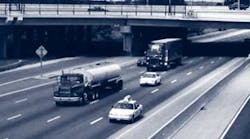The International Assn. for Counterterrorism and Security Professionals (IACSP) is “cautiously optimistic” about the effectiveness of the Dept. of Homeland Security’s (DHS) pilot program to use radiation-detection devices to find dirty bombs before they enter New York City. If the pilot is successful, the DHS aims to deploy the program in major cities across the U.S.
DHS has not elaborated on how its Securing the Cities Initiative will look once it’s finalized, but said it is still considering “ways in which [DHS] could best capture a detection of radioactive material coming in” without disrupting traffic flow using both stationary and mobile equipment. The pilot began in “the last few months” and its timetable is “being worked on,” DHS said.
Read DHS to pilot dirty-bomb checkpoints
“Those that transport such cargo don’t represent a significant portion of the industry so those who do transport it are already highly regulated and managed effectively,” Don L. Rondeau, president of IACSP senior director of homeland security and emergency preparedness for Alion Science and Technology. “It puts us one step closer to mitigating the risk of a vehicle-borne weapon that is radiological in nature.”
IACSP’s top concern about the pilot is its potential to slow the flow of traffic entering New York City. “So long as it doesn’t impact the American economy but protects us from the bad guys, I think this is the step in right direction,” Rondeau said.
But the radiation-detection device is far from perfect. Critics point out that first-generation models issue alarms when naturally radioactive freight is sent through—from granite to kitty litter. The first generation units cost about $180,000 per unit, with a more advanced model selling for $350,000 and the most advanced model could cost $500,000 to $600,000 per unit. DHS said it has begun to order the first 80 to 1,400 of advanced units.
In addition, DHS officials acknowledge that the detectors can only scan through unshielded and lightly shielded containers. DHS said it will announce an advanced radiography program that addresses “the shielded problem.”
“It is possible to shield a radiological material to impact its ability to be detected,” Rondeau said. “Lead shielding will minimize its ability to be detected. How easily speaks to the amount of shielding and speed of the vehicle. The bottom line is again that DHS continues to trend in its current direction in deploying layered security initiatives. This alone is not a silver bullet. But with secure ports and secure drive initiatives, now you start to get this strategic layered approach. If you were a bad guy, you would have to account for shielding, secure ports, a more robust intelligence gathering and a much more aware driver community.
“It’s already known that bad guys want to use a complex radiological device and history has shown us the enemy will convert our own transportation system into a weapon,” Rondeau continued. “The same can be said for the attack on Sept. 11—those weren’t missiles they used—they converted the actual transportation infrastructure into the weapon itself.”
To comment on this article, write to Terrence Nguyen at [email protected]




